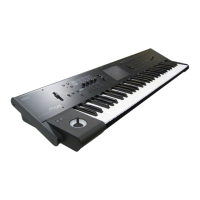Appendices
384
Knobs 1–4
Realtime Control knob 1–4 have preset assignments, as
below:
Knob 1–A: CUTOFF (Filter Cutoff: CC#74)
This scales the cutoff frequency of all of the filters at once.
Knob 2–A: RESONANCE (Filter Resonance: CC#71)
This scales the resonance of all of the filters at once.
Knob 3–A: EG INTENSITY (Filter EG Intensity: CC#79)
This scales the effect of the Filter EG on the cutoff frequency.
Knob 4–A: EG RELEASE (Filter, Amplifier EG Release:
CC#72)
This scales the release times of the Filter and Amp EGs.
Foot Switch Assignments
You can connect a footswitch (such as the optional Korg PS-
1) to the rear-panel ASSIGNABLE SWITCH input, and then
use it to control a wide variety of functions, as described
below.
This setting is made globally, on the Global P2: Controllers–
Foot Controllers page.
Foot Switch and MIDI CCs
Some of the assignments include MIDI CCs, which are
transmitted each time the switch is turned on or off (Off = 0,
and On = 127). Note that the MIDI CCs can still be received
even if they are not assigned to a physical controller.
RT Knob 1-B – 4-B and SW1/2 are special cases, since these
can themselves be assigned to different MIDI CCs. If the
footswitch is assigned to duplicate these controls, it will also
use their CC assignments.
List of Foot Switch assignments
Off
This setting disables the switch.
Foot Switch (CC#82)
This lets you use the switch as an AMS or Dmod source.
Note that you’ll also need to assign Foot SW (CC#82) to
control the desired parameter within the Program or Effect.
Portamento SW (CC#65)
This controls portamento on/off. For more information,
please see “Porta.SW (CC#65) (Portamento SW: CC#65)” on
page 382.
Sostenuto (CC#66)
This controls the sostenuto effect, which holds only the
notes being played at the moment that the footswitch is
turned on.
Soft (CC#67)
Turns the soft pedal effect on and off.
Damper (CC#64)
Turns the damper pedal effect on and off.
Program Up
This lets you use the switch to increment the current
Program or Combination number, for hands-free patch
changes. Note that this is only active while on the Prog P0:
Play or Combi P0: Play pages, respectively.
When you use this control, the M50 will also transmit the
corresponding MIDI Program Change and Bank Select
messages.
Program Down
This decrements the current Program or Combination
number, for hands-free patch changes. For more
information, please see “Program Up,” above.
Value Inc
Operating the foot switch will produce the same operation
as pressing the q (INC) switch. For more information,
please see “Using a footswitch to select Programs” on
page 228.
Value Dec
Operating the foot switch will produce the same operation
as pressing the u (DEC) switch.
Song Start/Stop
The foot switch will control sequencer start/stop.
Simultaneously, a MIDI Start or Stop message will be
transmitted.
Song Punch In/Out
If Seq P0: Preference “Recording Setup” (0–1–8b) is set to
Manual Punch In, the switch can be used to punch-in and
punch-out when recording on the sequencer.
Cue Repeat Control
This is valid if the Repeat setting for each step in Seq P11:
Cue List is set to FS (11–1b). If you press the pedal switch
while a step is repeating, this will be the trigger to proceed
to the next step.
Tap Tempo
This duplicates the function of the front-panel TAP TEMPO
switch, for setting the system tempo in real-time.
ARP ON/OFF
The foot switch will turn the arpeggiator on/off.
DRUM TRACK ON/OFF
The foot switch will turn the Drum Track on/off.
JS+Y (CC#01)
The switch will control the effect produced by joystick
movement in the +Y direction (Vertical upward).
JS–Y (CC#02)
The switch will control the effect produced by joystick
movement in the –Y direction (Vertical downward).
Value Slider (CC#18)
The switch will control the effect of the VALUE slider.
RT Knob1–A…4–A
RT Knob1–B…4–B
Use the switch to control the effect of knobs 1–4 when the
control surface is in Realtime Control A/B modes.
(Foot switch “on” is equivalent to turning the knob to the far
right; foot switch “off” is equivalent to turning the knob to
the far left.)
SW1, 2
The footswitch duplicates the function of the selected front-
panel switch.
ARP GATE
Use the switch to control the arpeggiator’s Gate.
(Foot switch “on” is equivalent to turning the knob to the far
right; foot switch “off” is equivalent to turning the knob to
the far left.)
ARP VELOCITY
Use the switch to control the arpeggiator’s Velocity.
(Foot switch “on” is equivalent to turning the knob to the far
right; foot switch “off” is equivalent to turning the knob to
the far left.)

